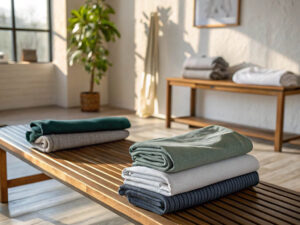A good yoga shirt should feel like a second skin—letting you breathe, move, and flow without distractions. But not all yoga tops are created equal, and the difference often comes down to one thing: the fabric.
The best material for yoga shirts is a blend of synthetic and natural fibers, such as polyester-spandex1 or nylon-spandex for performance, or cotton-bamboo blends for comfort. The ideal fabric is lightweight, moisture-wicking, breathable, and soft.
Let’s explore the most popular materials for yoga shirts, and how to choose the best one for your yoga style, comfort, and sweat level.
Why does material matter for yoga shirts?
Unlike regular tees, yoga shirts need to work with your body—not against it.
A yoga shirt has to stretch with you, wick away sweat, and stay in place whether you’re in Downward Dog or Savasana. The fabric is what makes this possible.
Key Requirements for a Great Yoga Shirt:
✔ 4-way stretch – To move with your body
✔ Moisture-wicking – To keep you dry during sweat sessions
✔ Breathable – To prevent overheating
✔ Soft and lightweight – To stay comfortable for long sessions
✔ Durable – To withstand frequent washing and wear
Now, let’s break down the top fabrics that meet these needs.
Is polyester-spandex the best blend for yoga shirts?
For many, yes—especially for active or sweaty sessions.
Polyester-spandex blends are the go-to for performance yoga shirts because they’re moisture-wicking, flexible, and fast-drying.
Benefits:
✔ Excellent stretch and recovery
✔ Feels cool and smooth on the skin
✔ Doesn’t absorb sweat—wicks it away instead
✔ Holds shape after many washes
Best For:
- Hot yoga
- Power yoga
- Vinyasa flow
- Outdoor practice
Look for shirts labeled “performance” or “technical” with at least 10–20% spandex for mobility.

How does nylon compare to polyester?
Nylon is another top performer—often used in premium yoga shirts.
Nylon-spandex blends feel softer and smoother than polyester, with similar stretch and sweat-wicking properties.
Benefits:
✔ Silky hand-feel
✔ Excellent drape and shape retention
✔ Lightweight and breathable
✔ Often more durable than polyester
Best For:
- Studio classes
- Daily wear-to-practice transitions
- Fitted or seamless yoga tops
While slightly more expensive, nylon-based shirts offer a luxe feel and long-term value.
Are cotton yoga shirts a good idea?
They’re great for light practice—but not ideal for sweaty flows.
Cotton is breathable and soft, but it absorbs moisture instead of wicking it away. That makes it less suitable for high-intensity yoga.
Pros:
✔ Natural fiber
✔ Comfortable for gentle movement
✔ Affordable and widely available
Cons:
✘ Retains sweat, can feel heavy
✘ May stretch out or lose shape
✘ Slow to dry
Best For:
- Yin yoga
- Restorative yoga
- Lounge-style practice or warmups
Look for cotton blended with spandex or polyester for better function.
What about bamboo or modal yoga shirts?
These offer a soft, sustainable alternative to synthetics.
Bamboo viscose and modal fabrics are naturally breathable, moisture-absorbing, and super gentle on skin—perfect for comfort-focused yogis.

Bamboo:
✔ Naturally antibacterial
✔ Temperature-regulating
✔ Eco-friendly and renewable
✘ May require gentle washing
✘ Less stretchy unless blended
Modal:
✔ Ultra-soft and smooth
✔ Drapes beautifully
✔ Lightweight for hot climates
✘ Not as moisture-wicking unless blended
Best For:
- Slow yoga
- Meditation or stretching
- Everyday wear with yoga-inspired style
Choose blends with spandex to maintain shape and movement.
What fabric weights are best for yoga shirts?
Weight matters—too thick, and it traps heat; too thin, and it may be see-through.
Fabric Weight Guide:
| Weight | Feel | Ideal Use |
|---|---|---|
| Lightweight | Airy, barely there | Hot yoga, outdoor summer sessions |
| Midweight | Balanced, soft | Everyday yoga practice |
| Heavyweight | Dense and warm | Layering, winter classes, warm-ups |
Look for "featherweight" or “tech jersey” labels if you prefer that barely-there feel.
How to choose the right yoga shirt material by yoga style?
Different practices call for different performance features.
Yoga Style Matching:
| Yoga Style | Ideal Fabric |
|---|---|
| Hot Yoga / Bikram | Polyester-spandex or nylon-spandex |
| Vinyasa / Power | Nylon-spandex or moisture-wicking poly blends |
| Yin / Restorative | Bamboo, modal, or cotton blends |
| Hatha / Gentle Flow | Light cotton or modal with stretch |
| Outdoor Yoga | Quick-dry polyester with UV protection |
The more intense the session, the more you should prioritize synthetic blends.
What about eco-friendly yoga shirt materials2?
Sustainability is growing in the yoga apparel space.
Brands are using recycled polyester, organic cotton, bamboo, and Tencel to make performance shirts that are better for the planet.
Sustainable Fabric Options:
✔ rPET (recycled polyester) – Same feel, less waste
✔ Organic cotton – Non-GMO, pesticide-free
✔ Bamboo viscose – Renewable and biodegradable
✔ Tencel / Lyocell – Made from wood pulp, ultra soft and breathable
Look for certifications like OEKO-TEX or GOTS for trustworthy sustainability claims.
How to test fabric quality before buying a yoga shirt?
Here’s how to know a shirt will hold up during practice:
Test Checklist:
- ✔ Stretch the fabric – Does it bounce back?
- ✔ Feel the texture – Smooth and soft = high comfort
- ✔ Hold to the light – Thin spots = risk of transparency
- ✔ Check the label – Look for blends with spandex or elastane
- ✔ Do a movement test – Lift arms, twist torso—does it shift or ride up?
A good yoga shirt should stay put and feel invisible while you move.
Conclusion
The best material for yoga shirts combines stretch, breathability, moisture management, and comfort. Performance blends like polyester-spandex or nylon-spandex are ideal for active yoga, while natural fibers like bamboo and cotton work well for slower styles. Choose based on your practice, preferences, and how much you sweat—and your yoga shirt will support every movement, breath, and flow.














